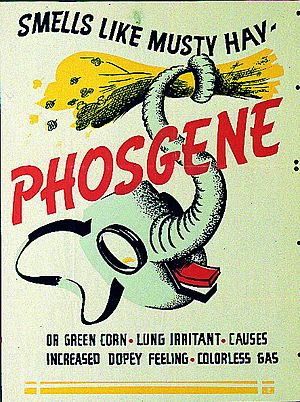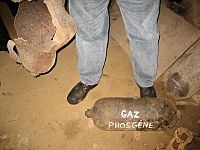Phosgene facts for kids
Phosgene is the chemical compound with the formula COCl2. This gas has no color. The gas was used as a weapon during World War I. It is responsible for most of the deaths related to poison gas during the war. Today, phosgene is used as a tool. It is used for organic synthesis. When there is a small amount in the air, the smell is similar to that of freshly cut hay or grass. Some soldiers during the First World War have stated that it smelled a little like May Blossom. When some compounds of chlorine burn or break down, small amounts of phosgene are given off.
Contents
Uses
Today, most phosgene is used to produce isocyanates. The most important isocanates in this context are toluene diisocyanate (TDI) and methylene diphenyl diisocyanate (MDI). Both are precursors to polyurethanes. Large amounts are also used to produce polycarbonates. Polycarbonate is produced from its reaction with bisphenol A. Polycarbonates are an important class of engineering thermoplastic. They can be found in lenses in eyeglasses.
Safety

Phosgene is a strong poison. Its smell may not be noticed. Signs of exposure may sometimes be detected slowly. Phosgene can be seen at 0.4 parts per million. This amount is four times the safe amount. Its high ability to poison doesn't come from the hydrogen chloride released by a process. It comes from the action of the phosgene on the proteins in the pulmonary sac of the lungs. The sacs are where the oxygen goes into the body. Their damage makes it hard for the blood and air move oxygen and carbon. This will make breathing very hard. Badges are worn by those at risk of exposure.
Sodium bicarbonate may be used to make spills of phosgene harmless. Gas spills may be made harmless with a special liquid spray.
Images for kids
See also
 In Spanish: Fosgeno para niños
In Spanish: Fosgeno para niños




